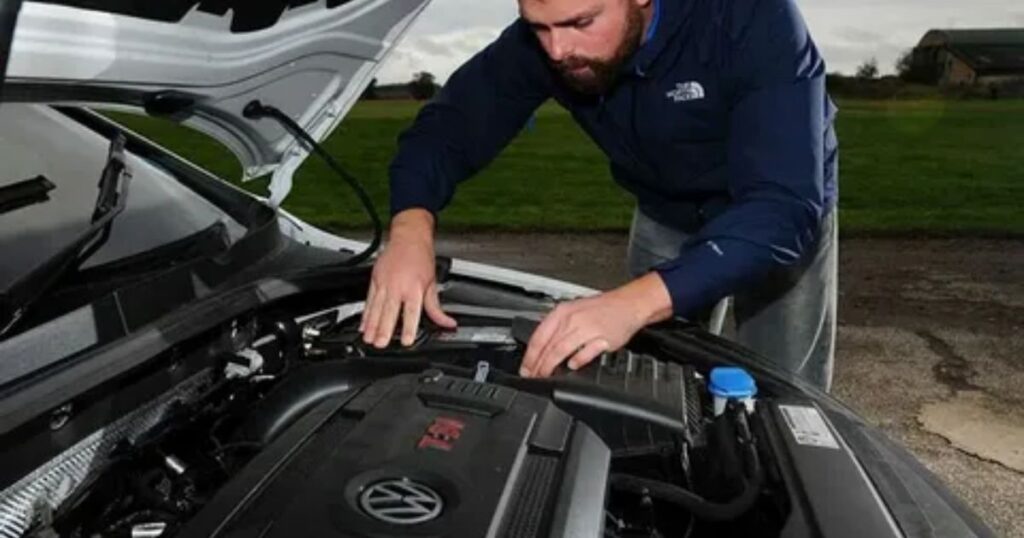Keep electronics cool in a hot car means protecting your devices from extreme temperatures inside a vehicle. This involves preventing overheating of smartphones, laptops, tablets, and other gadgets when left in a parked car.
Imagine returning to your car, only to find your phone too hot to touch. Your tablet won’t turn on, and your laptop is making strange noises. Sound familiar? These scenarios are all too common when electronics are left in a hot car.
Essential tips for protecting your electronics from car heat include using sunshades, proper storage techniques, and cooling accessories. These methods can significantly reduce the risk of heat damage to your devices.
Effects of How to Keep Electronics Cool in a Hot Car: Essential Tips for Protection

Dangers of Overheating
Let’s face it: electronics and extreme heat go together about as well as ice cream and a hot sidewalk. When your car bakes under the sun, it becomes a miniature sauna, and your beloved devices are the unwilling spa-goers. But why exactly is this such a big deal?
Think of your gadgets as tiny, high-tech athletes. Just like how you’d struggle to run a marathon in 100-degree weather, your devices can’t perform at their best when they’re overheating.
The internal components of your electronics are designed to operate within specific temperature ranges. When these limits are exceeded, all sorts of funky things start happening under the hood (or, in this case, under the screen).
Read More: The Ultimate Guide to Finding the Best Ceramic Coating Installer Near You
Common Damages Caused by Heat
- Battery Meltdown Your device’s battery is like a temperamental diva – it doesn’t do well under pressure, especially heat pressure. Extreme temperatures can cause the battery to expand, leak, or even explode in severe cases.
2. Screen Sizzle: Ever seen those weird, dark spots on an old TV screen? High temperatures can cause similar issues with your device’s display. The liquid crystals in LCD screens can start to, well, melt, leading to dark spots, discoloration, or even complete failure.
3. Circuit Board Blues: The delicate circuitry inside your devices isn’t built for saunas. Prolonged exposure to heat can cause solder joints to weaken or even melt, leading to short circuits or component failure.
4. Storage Meltdown: Your device’s storage systems, whether solid-state or traditional hard drives, are also at risk. Heat can cause data corruption or even complete failure, potentially leading to the loss of all your precious photos, documents, and that killer playlist you spent hours curating.
5. Performance Throttling: Even if your device survives the heat without physical damage, it might start to act like it’s running through molasses. Many devices have built-in protective measures that slow down performance to prevent overheating, which means your speedy smartphone might start moving at the pace of a sleepy sloth.
Best Practices for Cooling Electronics
Proper Ventilation
Just like how you’d crack a window to let out some steam in a hot room, your electronics need good airflow to stay cool. Here are some tips to keep the air moving and your gadgets chilling:
1. Do not Suffocate Your Tech: Avoid leaving devices in enclosed spaces like glove compartments or center consoles. These areas trap heat and turn into mini ovens.
2. Create a Breeze: If you must leave a device in the car, try to position it where air can circulate. The footwell area or under a seat can be cooler than the dashboard or rear parcel shelf.
3. Crack Those Windows: If it’s safe to do so, leave your windows slightly open. Even a small gap can allow hot air to escape and prevent your car from turning into a greenhouse.
4. Use Your AC Wisely: Before you exit your car crank up the AC for a few minutes. This cools down the interior and gives your electronics a head start in the battle against heat.
Use of Sunshades and Reflective Covers
Turning your car into a cool cave isn’t just about comfort – it’s a lifesaver for your electronics. Here’s how to shield your tech from the sun’s relentless rays:

1. Windshield Warriors: Invest in a good quality windshield sunshade. These reflective shields can dramatically reduce the interior temperature of your car.
2. DIY Dazzle: On a budget? Create your own sunshade using reflective bubble wrap or even cardboard covered in aluminum foil. It might not win any beauty contests, but it’ll keep your car cooler.
3. Window Wizardry: Don’t forget about the side and rear windows. Mesh sunshades or even lightweight towels can help block out the sun.
4. Reflect and Protect: Consider using a reflective car cover if you’re parking for extended periods. It’s like giving your entire car a suit of sun-resistant armor.
Read More: 6 Best Car Air Mattresses of 2024
Strategies for Temperature Regulation
Utilizing Car Fans
Who says fans are just for keeping humans cool? Your electronics could use a personal cooling system too. Here’s how to set up a breezy paradise for your gadgets:
1. Portable Power: Invest in a small, USB-powered fan. These can be plugged into your car’s power outlet and directed at your devices.
2. Strategic Placement: Position the fan to create a flow of air across your devices. This helps dissipate heat more effectively.
3. Multi-Device Cooling: If you have multiple devices, consider a fan with multiple heads or a larger desk-style fan that can cover a wider area.
4. Solar Savvy: For an eco-friendly option, look into solar-powered car fans. They’ll keep working even when your car is off, using the very sun that’s causing the heat to combat it.
Avoiding Direct Sunlight Exposure
Playing hide and seek with the sun isn’t just a game – it’s a crucial strategy for keeping your electronics cool. Here’s how to become a master of sun dodging:
1. Shadow Seeker: When parking, look for shaded areas. Trees, buildings, or parking structures can be your allies in the fight against the sun.
If you can’t avoid parking in the sun, cover your dashboard with a light-colored towel. This not only protects your dash but also reduces heat reflection onto your devices.
3. Glove Box Getaway: For small devices like phones or portable chargers, the glove box can be a cooler retreat. Just remember to crack it open slightly for ventilation.
4. Tinted Triumph: Consider getting your car windows tinted (within legal limits, of course). This can significantly reduce the amount of heat entering your car.
Cooling Accessories for Electronics
Cooling Pads and Mats
Welcome to the high-tech world of gadget air conditioning! Cooling pads and mats are like personal ice packs for your electronics. Here’s the scoop on these cool customers:
1. Laptop Loungers: If you frequently use your laptop in the car (not while driving, we hope!), a laptop cooling pad is a must. These nifty devices use fans to circulate air underneath your laptop, whisking away heat.
2. Phone Chillers: Yes, they make cooling pads for phones too! These often use thermoelectric cooling to keep your phone from turning into a hand warmer.
3. Universal Coolers: Some cooling mats are designed to accommodate multiple devices. These are great for family road trips where everyone’s gadgets need a cool place to hang out.
4. Power Play: Look for cooling accessories that can be powered by your car’s USB port or cigarette lighter. This ensures they can keep working even on long journeys.
Thermal Insulation Materials
The best defense is a good offense. Thermal insulation materials act like a protective cocoon for your devices, shielding them from the heat. Here’s how to wrap your tech in a cool embrace:
1. Bubble Wrap Brilliance: Believe it or not, bubble wrap isn’t just for popping stress away. Its air pockets provide excellent insulation. Wrap your devices in bubble wrap before leaving them in the car.
2. Foam Fantastic: Foam insulation sheets can be cut to size and used to line a small cooler or box for your electronics.
3. Reflective Rescue: Emergency blankets (those shiny, foil-like sheets) make excellent improvised insulation. Wrap your devices or line a storage container with them.
4. Neoprene Know How: Neoprene sleeves, like those used for laptops, provide good insulation. Look for ones designed specifically for heat protection.
Smart Storage Solutions
Choosing Ideal Locations in the Car
Not all spots in your car are created equal when it comes to heat. Here’s a guide to the coolest real estate in your four-wheeled oven:

1. Under Seat Sanctuary: The space under the front seats often stays cooler than other parts of the car. It’s shaded and can benefit from any AC that’s running.
2. Trunk Triumph: Your trunk, especially in sedans, tends to stay cooler than the main cabin. It’s out of direct sunlight and often better insulated.
3. Floor Level Fresh: The footwell areas, particularly on the passenger side, can be cooler than higher spots in the car. Hot air rises, after all.
4. Center Console Coolness: If your center console is ventilated, it can be a good spot for small devices. Just make sure it’s not completely sealed off.
Tips for Storing Electronics Safely
Creating a mini-fridge environment for your devices doesn’t require actual refrigeration. Here are some clever storage hacks to keep your tech cool:
1. Cooler Conversion: A small insulated cooler can become a tech haven. Line it with a towel (to prevent condensation issues) and use it to store your devices.
2. Thermal Bag Trick: Those insulated bags used for groceries? They’re great for electronics too. They keep the cold in and the heat out.
3. Ventilated Container: Use a plastic container with holes drilled in it for ventilation. Line it with insulating material for an extra cooling boost.
4. Seat Cover Secret: Some car seat covers come with built-in coolers or insulated pockets. These can be perfect for stashing your phone or tablet.
Emergency Cooling Measures
Quick Cooling Techniques
Sometimes, despite our best efforts, our devices end up hotter than a jalapeno on a summer day. Here’s your first aid kit for overheated gadgets:
1. AC to the Rescue: If your device is hot, turn on the car’s AC full blast and hold the device in front of a vent. But beware of rapid temperature changes!
2. Fan Frenzy: Use a portable fan to blow air directly over the device. This helps dissipate heat quickly.
3. Cool Cloth Technique: Wrap the device in a slightly damp, cool cloth. Don’t use anything too wet, and definitely avoid ice or very cold water.
4. Power Down: Turn off the device immediately. Continuing to use an overheated gadget can cause permanent damage.
Temporary Solutions
Sometimes you need to get MacGyver-level creative to keep your tech cool. Here are some improvised solutions for unexpected heat waves:
1. Makeshift Sun Shield: Use a light-colored t-shirt or towel to create a quick sunshade for your device.
2. Water Bottle Buddy: Place your device near (but not touching) a cool water bottle. As the water warms it absorbs heat from the surrounding area.
3. Paper Fan Hack: In a pinch a simple paper fan can help move air around your device. It’s low tech but it works!
4. Elevation Station: Prop up your device on something that allows air to circulate underneath. Even a couple of pens can create enough space for better airflow.
The future is cool literally Car manufacturers and tech companies
Technological Innovations for Heat Management
The future is cool literally Car manufacturers and tech companies are constantly innovating to tackle the heat problem. Here’s a glimpse into the cutting-edge of keeping cool:
1. Smart Climate Control: Some newer cars come with climate systems that can be controlled remotely via smartphone apps. This allows you to cool down your car before you even reach it.
2. Thermal Management Systems: Advanced cars are being equipped with systems that actively manage heat distribution keeping sensitive areas (like where you might store electronics) cooler.
3. Phase Change Materials: These high-tech materials absorb heat as they melt and release it as they solidify, helping to regulate temperature in small spaces.
4. Thermoelectric Cooling: This technology uses electricity to transfer heat away from devices offering a more efficient cooling method than traditional fans.
Smart Temperature Monitoring Devices
Why watch the mercury when tech can do it for you? Here are some futuristic solutions for today’s hot cars:
1. Bluetooth Thermometers: Small, wireless thermometers can be placed in your car and monitored via your smartphone, alerting you when temperatures get too high.
2. Smart Car Adapters: Devices that plug into your car’s OBD II port can monitor various aspects of your vehicle, including internal temperature and send alerts to your phone.
3. Integrated Vehicle Apps: Many modern cars come with apps that allow you to monitor internal temperatures and receive alerts if they exceed safe levels.
4. AI Powered Climate Control: Some high end vehicles are beginning to use artificial intelligence to predict and manage internal temperatures based on various factors, including the presence of electronics.
Common Mistakes to Avoid
Leaving
Abandoning your gadgets in a hot car is like leaving a chocolate bar on a radiator it never ends well. Here’s why forgetfulness is your device’s worst enemy.
1. The Greenhouse Effect: Your car can heat up incredibly quickly, even on mild days. In just an hour, the internal temperature can rise by 40 degrees Fahrenheit or more.
2. Cumulative Damage: Even if your device survives one hot car experience, repeated exposure can lead to long-term damage and shortened lifespan.
3. Battery Drain: Heat causes batteries to discharge faster. You might return to find your device not only overheated but also out of juice.
4. Data Loss: Extreme heat can cause data corruption. That important presentation or those vacation photos could be at risk if you leave your laptop or phone in a hot car.
Using Improper Cooling Methods
Sometimes, in our rush to cool down our devices, we can end up doing more harm than good. Here are some cool intentions that can go terribly wrong:
1. The Ice Pack Incident: Placing your hot device directly on ice or an ice pack can cause condensation, which is water’s evil twin when it comes to electronics.
2. Refrigerator Folly: Putting your overheated phone in the fridge might seem like a quick fix, but the rapid temperature change can cause internal condensation.
3. Water Wisdom: Never use water directly on your device to cool it down. Even if your device is water-resistant, the temperature shock can cause damage.
4. Freeze Frame: The freezer is absolutely off-limits. The extreme cold can damage your device just as much as extreme heat.
FAQs
How to protect electronics from heat in a car?
Park in the shade, use sunshades, and store electronics in insulated bags. Employ cooling fans and ensure proper ventilation to prevent overheating.
How to keep electronics cool in hot weather?
To keep electronics cool in hot weather, park in shaded areas and use sunshades and reflective covers. Store devices in insulated bags and ensure proper ventilation.
How to keep computer cool in hot car?
To keep a computer cool in a hot car park in the shade and use sunshades to block direct sunlight. Use cooling pads or fans to promote airflow around the device.
How do you keep your phone cool in a hot car?
To keep your phone cool in a hot car, park in the shade and use sunshades to block direct sunlight. Store the phone in an insulated bag or cooler to minimize heat exposure.
How to protect a phone from heat?
To protect a phone from heat, keep it out of direct sunlight and store it in a shaded area. Use an insulated case or pouch for added protection against high temperatures.
Conclusion
Protecting electronics from heat in a hot car is essential for their longevity. Use sunshades, store devices in insulated bags, and ensure proper airflow. Avoid direct sunlight by parking in shaded areas whenever possible. These simple actions can prevent overheating and damage to your gadgets.
Focus on using cooling accessories like fans and pads to regulate temperature. Place electronics in cooler spots like the trunk or under seats. Avoid using quick cooling methods like ice packs or refrigerators, which may cause harm. Regularly check and care for your devices to keep them working smoothly.







